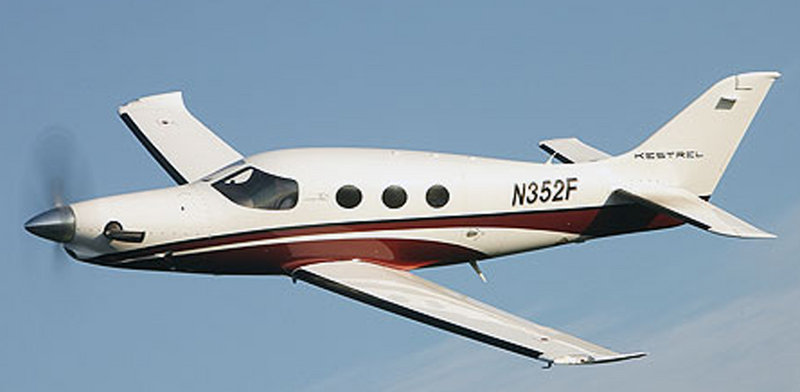Kestrel Aircraft Co. has decided to locate at the soon-to-be-closed Brunswick Naval Air Station, becoming the first major jobs-producing tenant at the site.
The company expects to employ about 300 people by the time it starts turning out high-tech composite turboprop planes that will carry six to eight passengers. Kestrel Aircraft needs to get federal certification for both the planes and the production facility, meaning it will be about three years before the aircraft are rolling out of the huge hangar the company will use.
Alan Klapmeier, chairman and chief executive officer of the company, said 300 jobs is “a target that we’ll hopefully pass through on the way to other numbers” as the company grows and adds new models.
Klapmeier said he knew of BNAS as “a kind of a hole in the middle of the state that you could not fly in” because of restrictions on the flight space due to military operations. Now, he said, it’s more a “black hole” that should pull in aviation companies attracted by its extensive facilities, many of which were upgraded just a few years before the decision was made to close the base. The hangar where Kestrel Aircraft will set up shop, for instance, is just seven years old.
Klapmeier said he became interested in locating in Brunswick during a meeting earlier this year with officials from Farnborough Aircraft, which developed the prototype of the Kestrel plane and is Klapmeier’s partner in the new company. Because he often flew to Maine when he was on the East Coast — he and his wife own property near Greenville where they eventually hope to build a home — he Googled “Brunswick Naval Air Station” and saw that it was being closed by the military and redeveloped by the Midcoast Regional Redevelopment Authority.
That led to a series of phone calls and visits that culminated in the announcement Friday that Kestrel Aircraft will be located at the former air station, which has been renamed Brunswick Landing.
Steve Levesque, executive director of the redevelopment authority, said Kestrel Aircraft fits into two industry categories that the agency has identified as key prospective tenants: aviation companies and those using composites, which is a growing industry used by Maine boat and windmill manufacturers.
“It hits the sweet spot for two of our targets,” he said.
Levesque said Kestrel Aircraft didn’t ask for a lot of incentives. The company will invest about $90 million and asked for a $10 million loan to help with financing. Levesque said the redevelopment authority also agreed to build some additions to the hangar — including a painting room and clean rooms — that will cost $1.5 million to $2 million, but he noted those probably would be required by any aviation-related tenant.
“This is wonderful for Maine,” Levesque said. “We have an opportunity to make an aerospace (industry) cluster that doesn’t now exist, and it will be an opportunity for Maine suppliers.”
A manufacturing company is particularly attractive, Levesque said, because most studies suggest that each manufacturing job supports five jobs at suppliers and other vendors.
“There’s a lot of pluses here and they’re great people to work with,” Levesque said.
“If you look up a ‘Who’s Who’ of aviation on the globe, you’ll find the Klapmeiers,” said Bill King, vice president of business administration for Minnesota-based Cirrus Aircraft, which Klapmeier and his brother Dale founded in 1984. The company makes two- and four-seat aircraft.
Klapmeier said he left Cirrus Aircraft two years ago after disagreements with an investor who became the company’s majority owner, including a dispute over development of a small jet that Klapmeier wanted to push ahead with and the owner did not.
King said Klapmeier is an innovator in the industry, especially in using lightweight but strong composite materials in fuselages. He also was the first to build huge parachutes into the frame of the aircraft that deploy to prevent crashes. King said the development has been credited with saving 35 lives.
Klapmeier added the chutes after he was involved in a midair collision with another plane. The crash killed the other pilot, but Klapmeier was able to land safely.
King said these are tough times for the small-aircraft industry because the recession is cutting into both corporate and personal spending. He said sales of Cirrus planes, which generally go for $300,000 to $600,000, are down by half compared with before the recession.
Klapmeier said the Kestrel, which will be larger than the Cirrus planes and also have a more powerful engine, will likely sell for about $2.5 million.
He said he’s enthused by both the facilities at Brunswick Landing, which he called “just ideal for a company like us,” and the prospect of spending more time in Maine.
“Minus 20 is a nice temperature to me,” said Klapmeier, noting that Cirrus Aircraft is located in northern Minnesota. “I consider Maine a nice southern state.”
Staff Writer Edward D. Murphy can be contacted at 791-6465 or at:
emurphy@pressherald.com
Send questions/comments to the editors.





Success. Please wait for the page to reload. If the page does not reload within 5 seconds, please refresh the page.
Enter your email and password to access comments.
Hi, to comment on stories you must . This profile is in addition to your subscription and website login.
Already have a commenting profile? .
Invalid username/password.
Please check your email to confirm and complete your registration.
Only subscribers are eligible to post comments. Please subscribe or login first for digital access. Here’s why.
Use the form below to reset your password. When you've submitted your account email, we will send an email with a reset code.